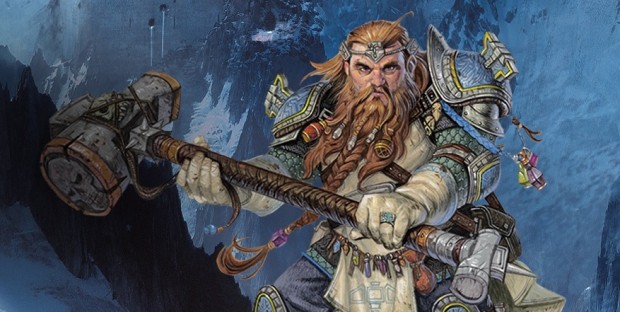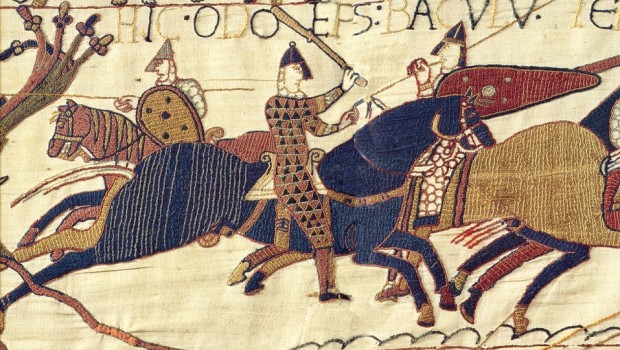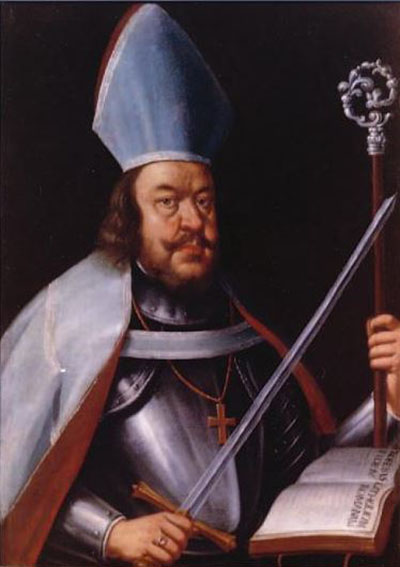Battling Bishops and Crushing Clerics: Why Can't Your RPG Healer Use A Sword?
Congratulations! You've finally decided to roll a healer in your latest MMORPG. The rest of us appreciate your sacrifice, your willingness to forgo damage and survivability to keep the rest of us squishy meatbags alive. We're proud of you, we really are.
But let's be honest – sometimes you just want to kill things. Pesky goblins, giant insects, gnomes … they can irritate even the most gentle and peaceful healer and make them want to go full berserker. When that happens, you've probably got a few spells at your disposal, along with your trusty sword –
Wait, no, that's not right. You don't get a sword. You've got a mace. Or a hammer. Or maybe, if you're really special, a fancy cudgel, a.k.a. a club. There are exceptions, but games that do limit weapon choice by class typically only allow healer-types to carry blunt weapons and not bladed ones. Why is that?
As with many conventions in gaming, it turns out there's historical precedent for that. Or there isn't. It all depends on where you look.
Philippe's blunt
Most Western RPGs and MMORPGs take place in a setting that superficially resembles medieval Europe. And in medieval Europe, Catholicism was the dominant religion. In modern times, we tend to think of Catholic priests and other clergy as men advanced in age without any particular physical prowess. You probably wouldn't want to take your local priest or bishop, and certainly not Pope Francis, into battle.
That wasn't always the case, however. In medieval times, priests routinely accompanied armies on the march. Their roles were typically to serve the soldiers' spiritual needs, as an Army chaplain would do today, but more than a few found themselves embroiled in the action.
One such militaristic man of the cloth was Philippe of Dreux, the Bishop of Beauvais, who participated in the Third Crusade in 1189. In later action against England, the French bishop was captured by the forces of King Richard “the Lionheart” of England. Despite the pope's pleading, Richard refused to release Philippe, claiming that he had been captured as a warrior, “a worthy knight, fully armed and with his helm laced,” and not as a holy man.
Philippe did eventually secure his freedom and went on to fight in the Battle of Bouvines in 1214, where, at the age of 63, he captured knights
“by unhorsing them with a mace before having some of his familia carry them away claiming the capture in order that he was not seen to have breached his vocation.” (Jones, Robert, Knight: The Warrior and World of Chivalry, Osprey Publishing, First Printing, 2011.)
Aha! A mace! But why didn't Philippe use a sword, lance or other pointy implement of death?
Smashing the mystery
If you're into gaming and have at least a casual interest in history, you might have heard of the supposed edict that states something to the effect that Catholic clergy were forbidden from shedding blood in battle – hence outlawing the use of bladed weapons but permitting blunt ones. I myself thought that was a real thing, probably issued by some medieval pope, but my research couldn't turn up any evidence of such a formal, all-encompassing decree.
Philippe aside, it appears that clerical armsbearing was, in fact, a fairly infrequent offense and not generally worthy of addressing by church leaders. Over 700 years, there were approximately 60 incidents of violence involving Cistercian monks and nuns. (Duggan Lawrence G., Armsbearing and the Clergy in the History and Canon Law of Western Christianity, The Boydell Press, First Printing, 2013.) That's a very small number, considering the thousands of men (and women) covered. As such, there may have been some edicts against the practice on a local level, but nothing so widespread as to affect the whole church.
The closest I could come to an actual widespread rule was from the Fourth Lateran Council of 1215. One of the orders – #18 in particular – laid out at that gathering of bishops stated that:
No subdeacon, deacon, or priest shall practice that part of surgery involving burning and cutting.
So that's something, at least – an actual edict that forbade priests from drawing blood with a blade. Granted, it was with regards to surgery, not battle, but it's possible that it might have served as the basis for the modern myth.
To help me solve this riddle, I looked up a medievalist friend, Jeff Sypeck, author of Becoming Charlemagne: Europe, Baghdad, and the Empires of A.D. 800, to ask if he knew of any rigid laws regarding clerical weapons of war. He said he was “fairly certain” that the concept sprung from the legend of Bishop Turpin (also known as Tilpin or Tulpin), who served under Charlemagne in the late eighth century and was notably warlike. According to legends, the bishop used a mace or flail in battle, and may have been an early inspiration for the “blunt weapon theory.”
He didn't believe, however, that there was a strict law regarding the use of such weapons. As he put it,
“I think the 'I can bash in your skull as long as I don't technically spill blood' rule is probably one of those 'too good to verify' pseudo-facts, because it confirms a modern tendency to believe that misbehaving religious people appeal to the letter of the law rather than the spirit.”
He then referred me to another military historian with a taste for gaming, Sean Manning, who echoed the notion that the supposed “law” was probably “someone with a vivid imagination [who] found one or two stories about clerics using maces and decided that it must have been a rule.” He mentioned the Bayeux Tapestry, which depicts the events of the Norman conquest of England in 1066. In particular, it depicts one Bishop Odo of Bayeux, who is clearly seen using a long, club-like weapon; in fact, the tapestry itself is believed to have been commissioned by Odo himself, who likely would have ensured that the details of his personal depiction were accurate!
Several sources state that clergymen who participated in the Battle of Hastings had to perform penance after the event, but whether it was for shedding blood specifically or simply related to the battle's general violence is unclear.
Manning also provided me with this anecdote:
During the Hundred Years' War, the English kings required clergy to equip themselves for the day that the wicked French pirates or Scottish marauders invaded, and as best as I can remember, the surviving muster rolls show them carrying the same bows, swords, daggers, and awful-spiky-pointy-things-on-sticks which other middling to wealthy men carried. (McNab, Bruce, “The Military Arrays of the Clergy, 1369-1418” in Jordan, McNab, and Ruiz eds., Order and Innovation in the Middle Ages, Princeton University Press, 1976)
Manning's mention of “middling to wealthy men” carrying swords and the like might also point to an economical reason why medieval priests might have favored blunt weapons. Bishops and high-ranking priests may have been able to afford a nice sword, but humbler priests might not have had the kind of resources for such an outlay of arms. That would have made a simple staff or club a more frugal choice of weapon, should the need arise to defend their village from invaders.
Paintings of holy men frequently show them carrying staves – often in the form of a shepherd's crook or topped with a cross – more as a badge of office than as a true weapon, and those depictions might also have influenced later game developers. In the case of someone like Philippe or Odo, it's possible that they learned to use simple blunt weapons – as many lowborn men might have done as a form of rudimentary self-defense training – early in their priestly careers and chose not to relearn a new, more complex, weapon once they rose in the ranks and could afford something better.
Mace to the face
All right, so if priests weren't restricted in their choice of weapons of war, why is it such a common convention in gaming?
Both Sypeck and Manning put forth that Gary Gygax – the primary creator of Dungeons & Dragons, from which most RPGs, tabletop and digital, spawned – used a variety of historical and fantastic sources for his work. They think that he might have come across the “clerics only use blunt weapons” myth from history and ran with it, and its presence in D&D spilled over into later games.
In fact, Sypeck was able to dig up for me an email from someone purporting to be in an early session of Chainmail (the precursor to D&D), run by Gygax himself in the early '70s, who apparently took a literal interpretation of Matthew 26:52. He states:
The bit about edged weapons was from Gary's reading the old stories about Archbishop Turpin [ed: later clarified to be Bishop Odo], who wielded a mace because he didn't want to shed blood ("who lives by the sword dies by the sword").
(The editorial comment is from the source, not from us.)
Like any good min-maxer, though, Gygax may also have had a gameplay-related reason for his decision. Clerics are the sworn foes of the undead, and many undead don't have internal organs – ones that have a use, anyway. Far better to smash a skeleton or bludgeon a zombie with a thick club or mace than to try stabbing one to pierce his non-functioning spleen!
Such distinctions have generally been lost in the digital age, where swords are just as effective against shambling necromantic hordes as anything. Some games, including more recent editions of Dungeons & Dragons, have softened or done away with the restriction entirely – especially if a cleric worships a particularly bloodthirsty deity who revels in the shedding of blood. But the tradition remains in several games and has left its mark upon the minds of many a middle-aged RPG-er, not to mention more than a few game designers.
Related Articles
About the Author

Jason Winter is a veteran gaming journalist, he brings a wide range of experience to MMOBomb, including two years with Beckett Media where he served as the editor of the leading gaming magazine Massive Online Gamer. He has also written professionally for several gaming websites.
More Stories by Jason WinterRead Next

World of Warships is setting sail on Xbox One and PlayStation 4 next year, with the launch of World of Warships: Legends.
You May Enjoy

A new spin on a classic genre.

Learn how to master the kit of Rogue, the latest Marvel Rivals Vanguard to join the roster in Season 5.5

If the rumors are true, they’re going to have a lot of interesting news for us.

The trip to Lahai-Roi is worth it.



Fin.